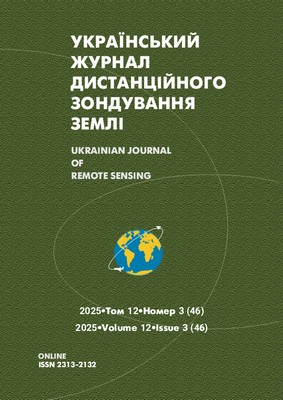Retrospective analysis and improvement of the informational and methodological foundations of aerospace monitoring of technogenic sea surface temperature anomalies
DOI:
https://doi.org/10.36023/ujrs.2025.12.3.288Keywords:
aerospace monitoring, temperature anomalies, sea surface, informative features, ship wake, structural-textural analysisAbstract
The article presents the results of a retrospective analysis of long-term experimental data obtained by the authors during field studies of sea surface temperature fields in the World Ocean using infrared remote sensing, laboratory modelling, and shadowgraph (Toepler) imaging. The study examines the formation features of technogenic temperature anomalies from moving surface and underwater objects, including ship wakes, in the context of natural hydrophysical and hydrological conditions. Previously known informative features have been refined for different climatic zones, seasons, and meteorological conditions. The results of adapting a structural-textural method based on Haralick’s informative features (GLCM analysis) are described, enabling the identification of technogenic thermal disturbances. The findings contribute to the improvement of the information base for aerospace monitoring of marine areas for the observation and control of maritime conditions.
References
Akimov, E. A., Stanychniy, S. V., Polonsky, A. B. (2014). Use of SEVIRI scanner data to assess the temperature of the surface layer of the Black Sea. Marine Hydrophysical Journal, 6, 37–46.
Albregtsen, F. (2008). Statistical texture measures computed from gray level co-occurrence matrices. https://api.semanticscholar.org/CorpusID:18927855
Clausi, D. A. (2002). An analysis of co-occurrence texture statistics as a function of grey level quantization. Canadian Journal of Remote Sensing, 28(1), 45–62. https://doi.org/10.5589/m02-004
Ewing, F., McAlister, E. D. (1960). On the thermal boundary layer of the ocean. Science, 131(3413), 1374–1375. https://doi.org/10.1126/science.131.3413.1374
Fedorovsky, A. D., Nykyforovych, Ye. I., Prykhodko, N. A. (1988). Mass transfer processes in gas-liquid systems. Kyiv: Naukova Dumka.
Fedorovsky, O. D., Khyzhnіak, A. V., Filimonov, V. Yu. (2021). Justification of the dual use of aerospace geomonitoring of the marine shelf: Hydrocarbon exploration and maritime situation “highlighting.” Space Science and Technology, 27(2), 38–44. https://doi.org/10.15407/knit2021.02.038
Fedorovsky, O. D., Nikiforovich, E. I., Filimonov, V. Yu. (1983, May 24–26). Thermal structure of the air–water interface and optical methods of its investigation. In Proceedings of the International Conference “Hydrodynamics and physical processes in liquids and dispersed systems” (pp. 317–320). Prague.
Fedorovsky, O. D., Sokolovska, A. V. (2015). Aerospace remote sensing studies in environmental management as an interdisciplinary scientific field (on the example of oil and gas prospect assessment of the Caspian shelf areas of Turkmenistan). Reports of the National Academy of Sciences of Ukraine, 3, 100–106. https://doi.org/10.15407/dopovidi2015.03.100
Haralick, R. M. (1979). Statistical and structural approaches to texture. Proceedings of the IEEE, 67(5), 786–804. https://doi.org/10.1109/PROC.1979.11328
Haralick, R. M., Shanmugam, K., Dinstein, I. (1973). Textural features for image classification. IEEE Transactions on Systems, Man, and Cybernetics, 3(6), 610–621. https://doi.org/10.1109/TSMC.1973.4309314
Lyalko, V. I., Popov, M. O., Fedorovsky, O. D. (Eds.). (2006). Multispectral methods of remote sensing of the Earth for environmental management. Kyiv: Naukova Dumka. ISBN 966-00-0403-1.
McAlister, E. D. (1964). Measurement of total heat flow from the sea surface. Applied Optics, 5(b), 188–201.
Pulinets, S. A. (2006). Space technologies for short-term earthquake warning. Advances in Space Research, 37(4), 643–652. https://doi.org/10.1016/j.asr.2005.03.161
Shchiptsov, O. A., Fedorovsky, O. D., Khyzhnіak, A. V. (2018). Aerospace monitoring of the shelf of the coastal zone of the Black Sea of Ukraine as a dual-use methodology. Visnyk of the National Academy of Sciences of Ukraine, 4, 68–75. https://doi.org/10.15407/visn2018.04.068
Downloads
Published
How to Cite
Issue
Section
License
Licensing conditions: the authors retain their copyrights and grant the journal the right of first publication of a work, simultaneously licensed in accordance with the Creative Commons Attribution License International CC-BY, which allows you to share the work with proof of authorship of the work and initial publication in this journal.
The authors, directing the manuscript to the editorial office of the Ukrainian Journal of Remote Sensing of the Earth, agree that the editorial board transfers the rights to protection and use of the manuscript (material submitted to the journal editorial board, including such protected copyright objects as photographs of the author, drawings, charts, tables, etc.), including reproduction in print and on the Internet; for distribution; to translate the manuscript into any languages; export and import of copies of the journal with the article of the authors for the purpose of distribution, informing the public. The above rights are transferred by the authors to the editors, without limitation of their validity, and in the territory of all countries of the world without limitation, including in Ukraine.
The authors guarantee that they have exclusive rights to use the submitted material. The editors are not liable to third parties for breach of data by the authors of the guarantees. The authors retain the right to use the published material, its fragments and parts for personal, including scientific and educational purposes. The rights to the manuscript are considered to be transferred by the authors of the editorial board from the moment of the publication of the issue of the journal in which it is published. Reprinting of materials published in the journal by other individuals and legal entities is possible only with the consent of the publisher, with the obligatory indication of the issue of the journal in which the material was published.
